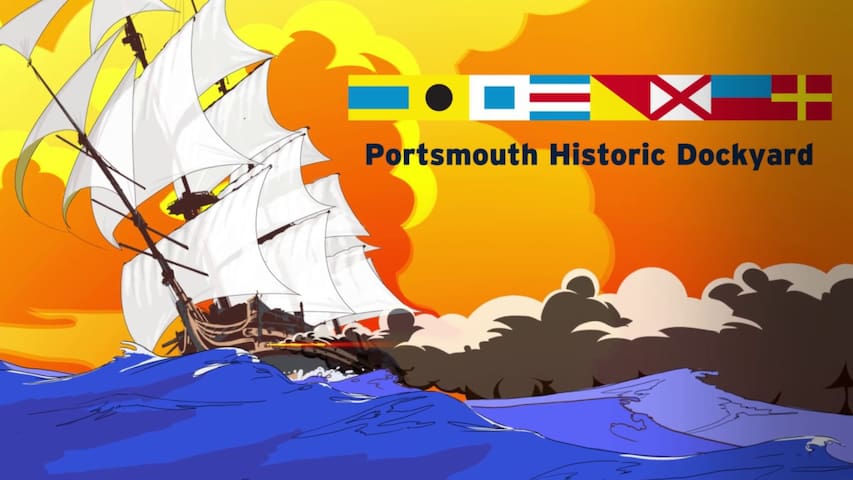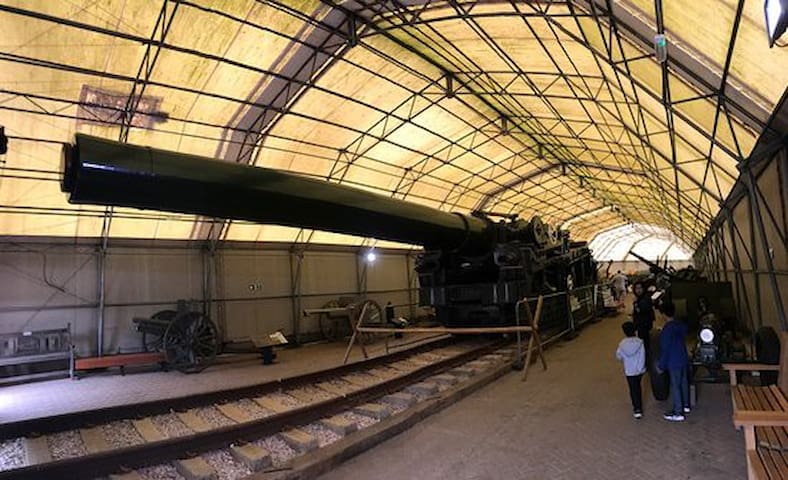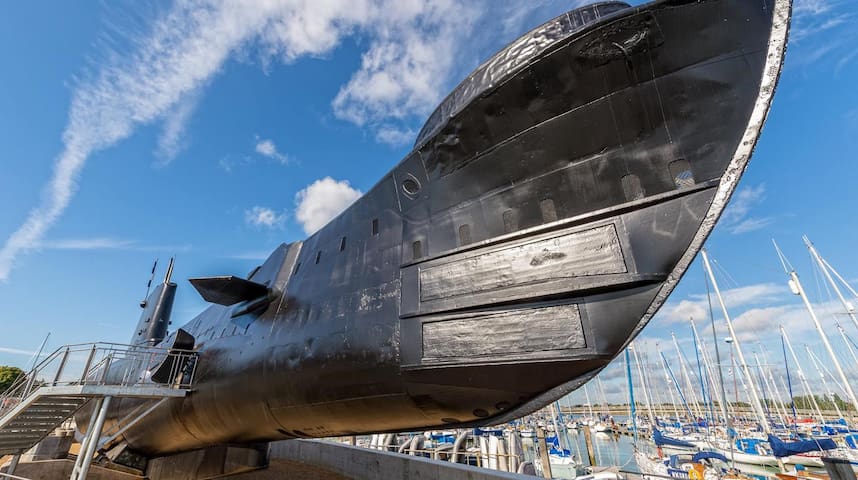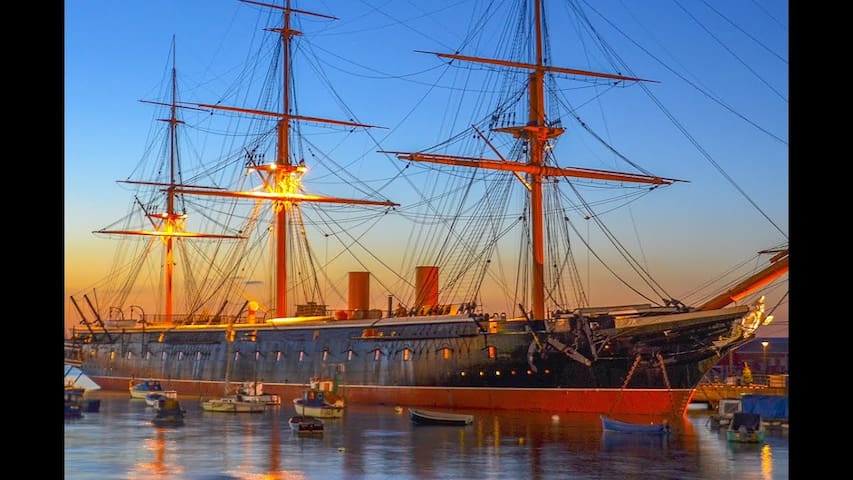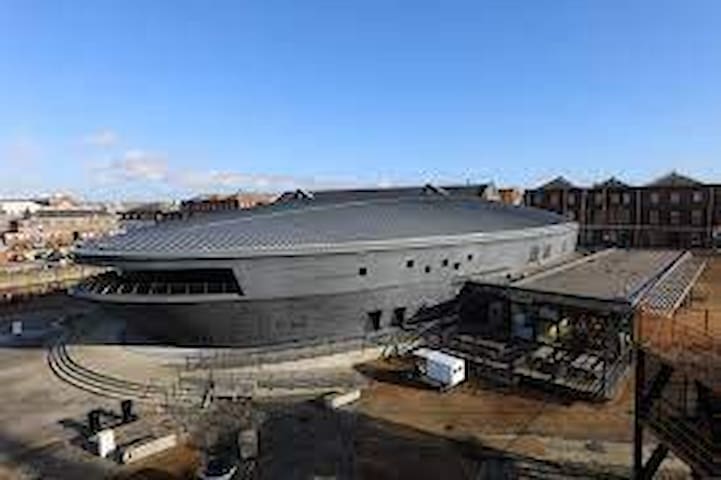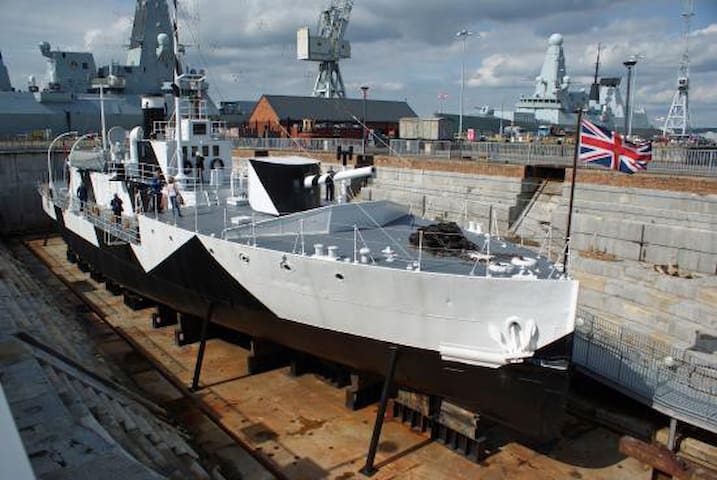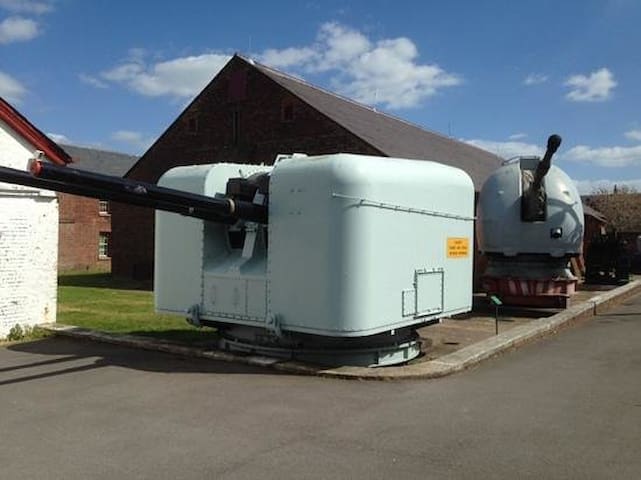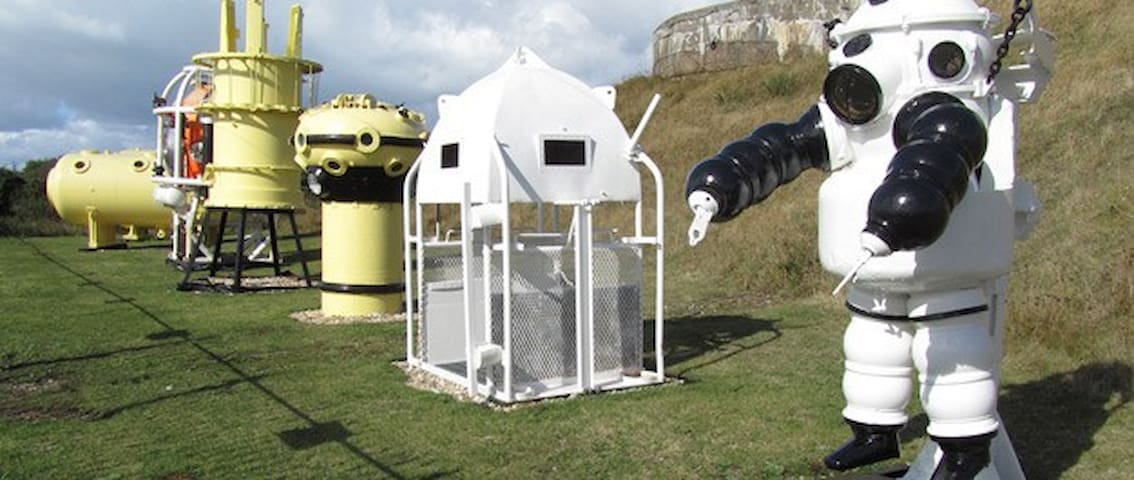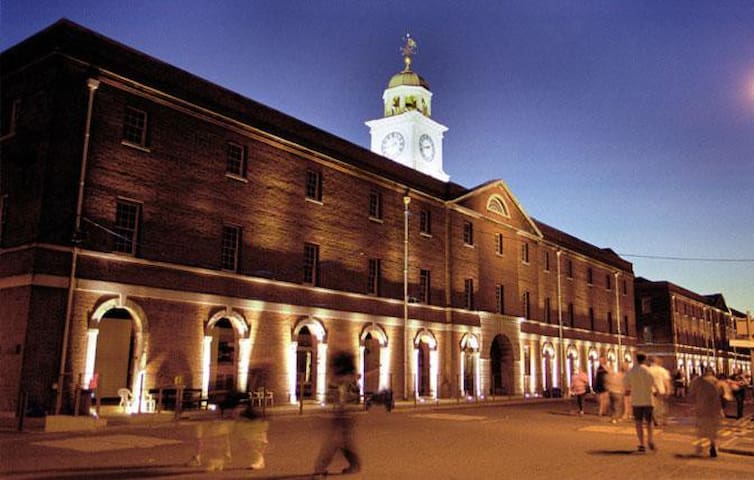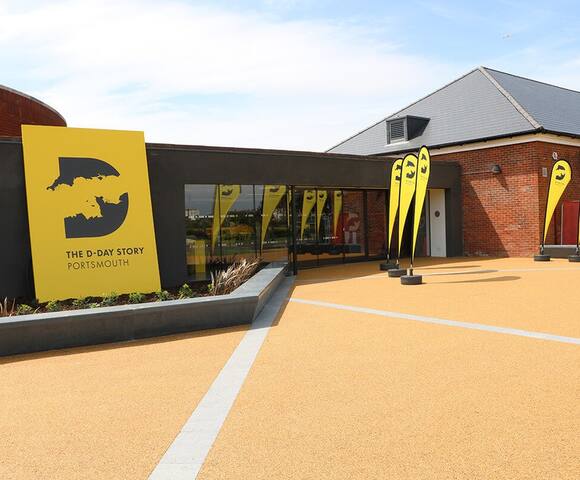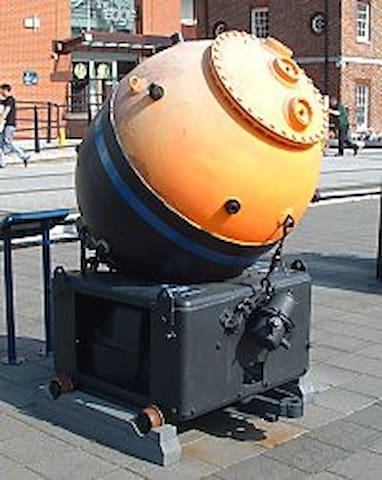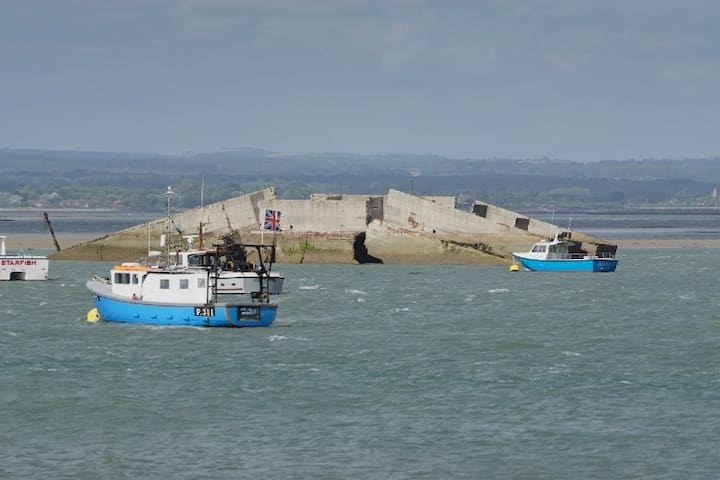Maritime History
LCT7074 - A VETERAN OF THE D-DAY LANDINGS
An incredible survivor, LCT is the last remaining Landing Craft Tank from D-Day, one of history’s most famous war time operations.
An incredible survivor, LCT is the last remaining Landing Craft Tank from D-Day, one of history’s most famous war time operations.
Experts from the Museum and the world of Marine Archology have been working alongside the D-Day Story museum, to restore this Second World War hero back to her former glory. This impressive restoration has been made possible thanks to a £4.7 million pound grant from the National Lottery Heritage Fund. When this ambitious project has been completed LCT 7074 will be on display to the public outside the D-Day Story Museum in Southsea alongside the stories of other D-Day heroes.
When she was rescued by the Museum, she was rusty, unloved and covered in barnacles! But now she is transformed. She has received a new external paint finish which brings back her disruptive pattern used to help with camouflage, her funnel has been replaced, important electrical works carried out and her replica guns and rocket launchers have been fitted.
She has also been moved to her new home outside the D-Day Story in Southsea. Just like D-Day moving this 300 tonne ship was a complex mission. The ambitious move took 3 days and started with LCT being placed on a barge in order to be tugged out of Portsmouth Naval Base. She then made the short journey by water to a beach near Southsea. Once on dry land, LCT was transported by road to Southsea Common. Two refurbished tanks where then installed on her decks before she was lifted into her final position.
Final touches are now being made to LCT 7074 before she opens to the public later this year.
The history of LCT 7074
LCT 7074 is a unique survivor from the Second World War. On 6 June 1944, more than 800 Landing Craft Tanks took part in D-Day’s Operation Neptune, the largest amphibious landing in history. Today, LCT is the only surviving Landing Craft Tank left from this momentous day.
This significant vessel is more than 57 meters long and weighs over 300 tons. During her time in active service she carried a crew of 12 men and her purpose was to carry troops and up to ten tanks to the beaches of Normandy.
After the Second World War, LCT had a varied history as she was repurposed into a floating clubhouse and nightclub from the 1960’s to 1980’, however she soon fell into disrepair. She was then rescued by the National Museum of the Royal Navy in 2014 and has now been restored to how she would have looked during the D-Day Landings.
Landing Craft LCT 7074
Clarence Esplanade LCT7074 - A VETERAN OF THE D-DAY LANDINGS
An incredible survivor, LCT is the last remaining Landing Craft Tank from D-Day, one of history’s most famous war time operations.
An incredible survivor, LCT is the last remaining Landing Craft Tank from D-Day, one of history’s most famous war time operations.
Experts from the Museum and the world of Marine Archology have been working alongside the D-Day Story museum, to restore this Second World War hero back to her former glory. This impressive restoration has been made possible thanks to a £4.7 million pound grant from the National Lottery Heritage Fund. When this ambitious project has been completed LCT 7074 will be on display to the public outside the D-Day Story Museum in Southsea alongside the stories of other D-Day heroes.
When she was rescued by the Museum, she was rusty, unloved and covered in barnacles! But now she is transformed. She has received a new external paint finish which brings back her disruptive pattern used to help with camouflage, her funnel has been replaced, important electrical works carried out and her replica guns and rocket launchers have been fitted.
She has also been moved to her new home outside the D-Day Story in Southsea. Just like D-Day moving this 300 tonne ship was a complex mission. The ambitious move took 3 days and started with LCT being placed on a barge in order to be tugged out of Portsmouth Naval Base. She then made the short journey by water to a beach near Southsea. Once on dry land, LCT was transported by road to Southsea Common. Two refurbished tanks where then installed on her decks before she was lifted into her final position.
Final touches are now being made to LCT 7074 before she opens to the public later this year.
The history of LCT 7074
LCT 7074 is a unique survivor from the Second World War. On 6 June 1944, more than 800 Landing Craft Tanks took part in D-Day’s Operation Neptune, the largest amphibious landing in history. Today, LCT is the only surviving Landing Craft Tank left from this momentous day.
This significant vessel is more than 57 meters long and weighs over 300 tons. During her time in active service she carried a crew of 12 men and her purpose was to carry troops and up to ten tanks to the beaches of Normandy.
After the Second World War, LCT had a varied history as she was repurposed into a floating clubhouse and nightclub from the 1960’s to 1980’, however she soon fell into disrepair. She was then rescued by the National Museum of the Royal Navy in 2014 and has now been restored to how she would have looked during the D-Day Landings.
The Full Navy Ticket includes entry to:
HMS Victory: The world’s most celebrated warship has undergone her biggest change. A major reinterpretation of her visitor route through the ship enables visitors to follow in the footsteps of Nelson, the ship's most famous Admiral.
HMS Warrior 1860: The world’s first iron-hulled, armoured warship launched in 1860 and never fired a shot in anger, yet changed naval warfare forever.
36 hours: Jutland 1916, The Battle That Won The War: This exhibition from The National Museum of the Royal Navy reveals the story behind the greatest naval battle in history.
The National Museum of the Royal Navy Portsmouth: Britain’s only museum dedicated to the men and women of the Royal Navy, spanning several hundred years.
Action Stations: Release your inner ninja on the new Ninja Force assault course. Measuring 20 metres by six metres, the course combines elements of Parkour, rock climbing and rope courses. It's suitable for anyone over six and visitors can have as many goes as they like.
Boathouse 4: A great new family attraction within the Historic Dockyard, Boathouse 4 features hands-on children’s activities; the rope making activity is especially popular. There is the Forgotten Craft exhibition, which pays tribute to the heroic small naval craft and crews of the past, or you can get a great birds-eye view of students practising traditional boatbuilding skills as part of the International Boatbuilding Training College Portsmouth.
HMS Alliance at the Royal Navy Submarine Museum: Discover a world beneath the sea by walking on board HMS Alliance - it’s as if she is about to leave for sea. Take a peek through the working periscopes and see, hear and even smell how life was lived underwater.
Explosion Museum of Naval Firepower: Take the free waterbus over to this award-winning museum – home to a unique collection that includes torpedoes, modern missiles - and even a nuclear bomb.
HMS M.33: Discover the only surviving ship from the First World War’s Gallipoli campaign.
Navigate the Dockyard Apprentice exhibition and see the skills of the men who made Portsmouth Dockyard the centre of the Industrial Revolution.
Harbour Tours: Get out on the water on a 45-minute Harbour Tour and get a sailor’s eye view of the Historic Dockyard and the warships of the modern Royal Navy.
Waterbus: Enjoy a complimentary boat ride from Portsmouth Historic Dockyard to the Royal Navy Submarine Museum and Explosion Museum (subject to availability and on a first come, first served basis).
Visiting
Portsmouth Historic Dockyard opens from 10am to 5:30pm April - October, and 10am to 5pm November - March. Last tickets are sold at 4.30pm (April – October) and 4pm (November – March). The Dockyard is closed on Christmas Eve, Christmas Day and Boxing Day.
345 ντόπιοι το προτείνουν
Ιστορικό Λιμάνι του Πόρτσμουθ
The Full Navy Ticket includes entry to:
HMS Victory: The world’s most celebrated warship has undergone her biggest change. A major reinterpretation of her visitor route through the ship enables visitors to follow in the footsteps of Nelson, the ship's most famous Admiral.
HMS Warrior 1860: The world’s first iron-hulled, armoured warship launched in 1860 and never fired a shot in anger, yet changed naval warfare forever.
36 hours: Jutland 1916, The Battle That Won The War: This exhibition from The National Museum of the Royal Navy reveals the story behind the greatest naval battle in history.
The National Museum of the Royal Navy Portsmouth: Britain’s only museum dedicated to the men and women of the Royal Navy, spanning several hundred years.
Action Stations: Release your inner ninja on the new Ninja Force assault course. Measuring 20 metres by six metres, the course combines elements of Parkour, rock climbing and rope courses. It's suitable for anyone over six and visitors can have as many goes as they like.
Boathouse 4: A great new family attraction within the Historic Dockyard, Boathouse 4 features hands-on children’s activities; the rope making activity is especially popular. There is the Forgotten Craft exhibition, which pays tribute to the heroic small naval craft and crews of the past, or you can get a great birds-eye view of students practising traditional boatbuilding skills as part of the International Boatbuilding Training College Portsmouth.
HMS Alliance at the Royal Navy Submarine Museum: Discover a world beneath the sea by walking on board HMS Alliance - it’s as if she is about to leave for sea. Take a peek through the working periscopes and see, hear and even smell how life was lived underwater.
Explosion Museum of Naval Firepower: Take the free waterbus over to this award-winning museum – home to a unique collection that includes torpedoes, modern missiles - and even a nuclear bomb.
HMS M.33: Discover the only surviving ship from the First World War’s Gallipoli campaign.
Navigate the Dockyard Apprentice exhibition and see the skills of the men who made Portsmouth Dockyard the centre of the Industrial Revolution.
Harbour Tours: Get out on the water on a 45-minute Harbour Tour and get a sailor’s eye view of the Historic Dockyard and the warships of the modern Royal Navy.
Waterbus: Enjoy a complimentary boat ride from Portsmouth Historic Dockyard to the Royal Navy Submarine Museum and Explosion Museum (subject to availability and on a first come, first served basis).
Visiting
Portsmouth Historic Dockyard opens from 10am to 5:30pm April - October, and 10am to 5pm November - March. Last tickets are sold at 4.30pm (April – October) and 4pm (November – March). The Dockyard is closed on Christmas Eve, Christmas Day and Boxing Day.
Fort Nelson, in the civil parish of Boarhunt in the English county of Hampshire, is one of five defensive forts built on the summit of Portsdown Hill in the 1860s, overlooking the important naval base of Portsmouth. It is now part of the Royal Armouries, housing their collection of artillery, and a Grade I Listed Building.
Fort Nelson is a typical Polygonal or Palmerston Fort. It is six-sided with a deep ditch protected by three caponiers. Above each caponier is a well-protected emplacement for 13-inch mortars. It was originally entered by two Guthrie rolling bridges and has a barrack block for 172 officers and men, protected by a V-shaped redan. A large open parade ground gives access to the magazines 40 feet underneath it. There are open emplacements on the ramparts for 64 pounder rifled muzzle-loading guns and RML 6.6-inch howitzers. There are also three Haxo casemates for 7 inch rifled breech-loaders.
Fort Nelson is one of five Portsdown Forts. Built as a result of the 1859 Royal Commission by Lord Palmerston to prevent a French land attack, on the Portsmouth dockyard only 8 kilometres away, because the older Hilsea Lines at the bottom of the ridge were considered insufficient. A series of 6 forts were built along the 7 miles (10 km) of the ridge. From west to east they are forts Fareham, Wallington, Nelson, Southwick, Widley and Purbrook. The line was finished off at the eastern end with Crookhorn Redoubt and Farlington Redoubt. A garrison of around 200 volunteers accompanied by regular army officers would have manned the fort in time of war. Construction was protracted and Fort Nelson wasn't fully armed until the 1890s. The fort was disarmed in 1907 and then used for accommodation. In 1938, it was converted to an area anti-aircraft ammunition store; ten large magazines were built on the parade ground. Fort Nelson was abandoned in the 1950s.
In 1979, after years of neglect and vandalism, it was sold to Hampshire County Council for £50,000. The Council, with assistance of volunteers from the Palmerston Forts Society, restored it at a cost of £3-4million, and it opened to the public in 1994, becoming part of the Royal Armouries in 1995. It houses their collection of artillery.
The fort covers around 19 acres (77,000 m2) and is open all year round, with no charges except for some special events. Live firing demonstrations are held every day, costumed guides, video presentations, and visitors are able to explore the tunnels that run below the fort connecting the magazines with gun emplacements. There are displays demonstrating the living and working conditions of the soldiers who manned the fort, and views over Portsmouth, the Solent, Hayling Island and Gosport, with the Isle of Wight beyond.
9 ντόπιοι το προτείνουν
Royal Armouries: Fort Nelson
Portsdown Hill RoadFort Nelson, in the civil parish of Boarhunt in the English county of Hampshire, is one of five defensive forts built on the summit of Portsdown Hill in the 1860s, overlooking the important naval base of Portsmouth. It is now part of the Royal Armouries, housing their collection of artillery, and a Grade I Listed Building.
Fort Nelson is a typical Polygonal or Palmerston Fort. It is six-sided with a deep ditch protected by three caponiers. Above each caponier is a well-protected emplacement for 13-inch mortars. It was originally entered by two Guthrie rolling bridges and has a barrack block for 172 officers and men, protected by a V-shaped redan. A large open parade ground gives access to the magazines 40 feet underneath it. There are open emplacements on the ramparts for 64 pounder rifled muzzle-loading guns and RML 6.6-inch howitzers. There are also three Haxo casemates for 7 inch rifled breech-loaders.
Fort Nelson is one of five Portsdown Forts. Built as a result of the 1859 Royal Commission by Lord Palmerston to prevent a French land attack, on the Portsmouth dockyard only 8 kilometres away, because the older Hilsea Lines at the bottom of the ridge were considered insufficient. A series of 6 forts were built along the 7 miles (10 km) of the ridge. From west to east they are forts Fareham, Wallington, Nelson, Southwick, Widley and Purbrook. The line was finished off at the eastern end with Crookhorn Redoubt and Farlington Redoubt. A garrison of around 200 volunteers accompanied by regular army officers would have manned the fort in time of war. Construction was protracted and Fort Nelson wasn't fully armed until the 1890s. The fort was disarmed in 1907 and then used for accommodation. In 1938, it was converted to an area anti-aircraft ammunition store; ten large magazines were built on the parade ground. Fort Nelson was abandoned in the 1950s.
In 1979, after years of neglect and vandalism, it was sold to Hampshire County Council for £50,000. The Council, with assistance of volunteers from the Palmerston Forts Society, restored it at a cost of £3-4million, and it opened to the public in 1994, becoming part of the Royal Armouries in 1995. It houses their collection of artillery.
The fort covers around 19 acres (77,000 m2) and is open all year round, with no charges except for some special events. Live firing demonstrations are held every day, costumed guides, video presentations, and visitors are able to explore the tunnels that run below the fort connecting the magazines with gun emplacements. There are displays demonstrating the living and working conditions of the soldiers who manned the fort, and views over Portsmouth, the Solent, Hayling Island and Gosport, with the Isle of Wight beyond.
DISCOVER THE STORY OF THE ROYAL NAVY UNDER THE SEA AT THE ROYAL NAVY SUBMARINE MUSEUM
Get up close to HMS Alliance at the Royal Navy Submarine Museum, the only remaining Second World War era submarine.
Explore the decks and narrow corridors, look through the original periscope and hear the stories of those who served onboard.
See the museum’s other submarines including Britain's first submarine "Holland I" and the midget submarine "X24" as well as photographs, documents, ship plans and artefacts from another time.
Discover Silent and Secret, a new exhibition which follows the Royal Navy's at sea nuclear deterrent telling the story of those who served under water for months at a time. See objects that retell hidden conflicts and first-hand accounts from crew onboard.
Take in the history of the site and find out what it was like to face danger underwater. See how a crew of 65 were fed in a galley the size of a broom cupboard.
42 ντόπιοι το προτείνουν
Το Μουσείο Υποβρυχίων του Βασιλικού Ναυτικού
Jetty RoadDISCOVER THE STORY OF THE ROYAL NAVY UNDER THE SEA AT THE ROYAL NAVY SUBMARINE MUSEUM
Get up close to HMS Alliance at the Royal Navy Submarine Museum, the only remaining Second World War era submarine.
Explore the decks and narrow corridors, look through the original periscope and hear the stories of those who served onboard.
See the museum’s other submarines including Britain's first submarine "Holland I" and the midget submarine "X24" as well as photographs, documents, ship plans and artefacts from another time.
Discover Silent and Secret, a new exhibition which follows the Royal Navy's at sea nuclear deterrent telling the story of those who served under water for months at a time. See objects that retell hidden conflicts and first-hand accounts from crew onboard.
Take in the history of the site and find out what it was like to face danger underwater. See how a crew of 65 were fed in a galley the size of a broom cupboard.
Welcome on board HMS Warrior 1860, Britain’s first iron-hulled, armoured battleship.
Launched in 1860, at a time of empire and Britain’s dominance in trade and industry, Warrior was the pride of Queen Victoria’s fleet.
Powered by steam and sail, she was the largest, fastest and most powerful warship of her day and had a lasting influence on naval architecture and design. Work and life on board reflected both the changes the Royal Navy experienced as it evolved into a professional service and shifts in Victorian society.
Built to counter the latest French battleship, Warrior was, in her time, the ultimate deterrent. Yet by igniting a new era in naval technology, she soon became outdated. After 22 years’ service, Warrior’s hull was to be used as a depot, floating school and an oil jetty.
Painstakingly restored in Hartlepool and back home in Portsmouth since 1987, Warrior is a unique survivor of the once formidable Victorian Black Battlefleet and now serves as a museum ship, visitor attraction, popular private hire venue and more.
Open all year round*, the Captain and crew invite you to come on board and explore this almighty Victorian battleship for yourself. The Ship’s company are also on hand to answer any questions you may have
19 ντόπιοι το προτείνουν
HMS Warrior
Welcome on board HMS Warrior 1860, Britain’s first iron-hulled, armoured battleship.
Launched in 1860, at a time of empire and Britain’s dominance in trade and industry, Warrior was the pride of Queen Victoria’s fleet.
Powered by steam and sail, she was the largest, fastest and most powerful warship of her day and had a lasting influence on naval architecture and design. Work and life on board reflected both the changes the Royal Navy experienced as it evolved into a professional service and shifts in Victorian society.
Built to counter the latest French battleship, Warrior was, in her time, the ultimate deterrent. Yet by igniting a new era in naval technology, she soon became outdated. After 22 years’ service, Warrior’s hull was to be used as a depot, floating school and an oil jetty.
Painstakingly restored in Hartlepool and back home in Portsmouth since 1987, Warrior is a unique survivor of the once formidable Victorian Black Battlefleet and now serves as a museum ship, visitor attraction, popular private hire venue and more.
Open all year round*, the Captain and crew invite you to come on board and explore this almighty Victorian battleship for yourself. The Ship’s company are also on hand to answer any questions you may have
The Mary Rose - Henry VIII's warship, lost in 1545, recovered in 1982 and now on display in a dedicated museum in Portsmouth for everyone to visit all year round.
The Mary Rose is a carrack-type warship of the English Tudor navy of King Henry VIII. After serving for 33 years in several wars against France, Scotland, and Brittany and after being substantially rebuilt in 1536, she saw her last action on 19 July 1545. While leading the attack on the galleys of a French invasion fleet, she sank in the Solent, the straits north of the Isle of Wight.
The wreck of the Mary Rose was rediscovered in 1971. It was raised on 11 October 1982 by the Mary Rose Trust, in one of the most complex and expensive projects in the history of maritime archaeology. The surviving section of the ship and thousands of recovered artefacts are of immeasurable value as a Tudor-era time capsule. The excavation and raising of the Mary Rose was a milestone in the field of maritime archaeology, comparable in complexity and cost only to the raising of the Swedish 17th-century warship Vasa in 1961.
The finds include weapons, sailing equipment, naval supplies and a wide array of objects used by the crew. Many of the artefacts are unique to the Mary Rose and have provided insights into topics ranging from naval warfare to the history of musical instruments. Since the mid-1980s, while undergoing conservation, the remains of the hull have been on display at the Portsmouth Historic Dockyard. An extensive collection of well-preserved artefacts is on display at the Mary Rose Museum, built to display the remains of the ship and its artefacts alongside each other.
The Mary Rose was one of the largest ships in the English navy through more than three decades of intermittent war and was one of the earliest examples of a purpose-built sailing warship. She was armed with new types of heavy guns that could fire through the recently invented gun-ports. After being substantially rebuilt in 1536, she was also one of the earliest ships that could fire a broadside, although the line of battle tactics that employed it had not yet been developed. Several theories have sought to explain the demise of the Mary Rose, based on historical records, knowledge of 16th-century shipbuilding, and modern experiments. The precise cause of her sinking is still unclear, because of conflicting testimonies and a lack of conclusive physical evidence.
54 ντόπιοι το προτείνουν
Μουσείο Mary Rose
Main RoadThe Mary Rose - Henry VIII's warship, lost in 1545, recovered in 1982 and now on display in a dedicated museum in Portsmouth for everyone to visit all year round.
The Mary Rose is a carrack-type warship of the English Tudor navy of King Henry VIII. After serving for 33 years in several wars against France, Scotland, and Brittany and after being substantially rebuilt in 1536, she saw her last action on 19 July 1545. While leading the attack on the galleys of a French invasion fleet, she sank in the Solent, the straits north of the Isle of Wight.
The wreck of the Mary Rose was rediscovered in 1971. It was raised on 11 October 1982 by the Mary Rose Trust, in one of the most complex and expensive projects in the history of maritime archaeology. The surviving section of the ship and thousands of recovered artefacts are of immeasurable value as a Tudor-era time capsule. The excavation and raising of the Mary Rose was a milestone in the field of maritime archaeology, comparable in complexity and cost only to the raising of the Swedish 17th-century warship Vasa in 1961.
The finds include weapons, sailing equipment, naval supplies and a wide array of objects used by the crew. Many of the artefacts are unique to the Mary Rose and have provided insights into topics ranging from naval warfare to the history of musical instruments. Since the mid-1980s, while undergoing conservation, the remains of the hull have been on display at the Portsmouth Historic Dockyard. An extensive collection of well-preserved artefacts is on display at the Mary Rose Museum, built to display the remains of the ship and its artefacts alongside each other.
The Mary Rose was one of the largest ships in the English navy through more than three decades of intermittent war and was one of the earliest examples of a purpose-built sailing warship. She was armed with new types of heavy guns that could fire through the recently invented gun-ports. After being substantially rebuilt in 1536, she was also one of the earliest ships that could fire a broadside, although the line of battle tactics that employed it had not yet been developed. Several theories have sought to explain the demise of the Mary Rose, based on historical records, knowledge of 16th-century shipbuilding, and modern experiments. The precise cause of her sinking is still unclear, because of conflicting testimonies and a lack of conclusive physical evidence.
HMS Victory is a 104-gun first-rate ship of the line of the Royal Navy, ordered in 1758, laid down in 1759 and launched in 1765. She is best known for her role as Lord Nelson's flagship at the Battle of Trafalgar on 21 October 1805.
She additionally served as Keppel's flagship at Ushant, Howe's flagship at Cape Spartel and Jervis's flagship at Cape St Vincent. After 1824, she was relegated to the role of harbour ship.
In 1922, she was moved to a dry dock at Portsmouth, England, and preserved as a museum ship. She has been the flagship of the First Sea Lord since October 2012 and is the world's oldest naval ship still in commission, with 241 years' service as of 2019.
56 ντόπιοι το προτείνουν
HMS Victory
Main RoadHMS Victory is a 104-gun first-rate ship of the line of the Royal Navy, ordered in 1758, laid down in 1759 and launched in 1765. She is best known for her role as Lord Nelson's flagship at the Battle of Trafalgar on 21 October 1805.
She additionally served as Keppel's flagship at Ushant, Howe's flagship at Cape Spartel and Jervis's flagship at Cape St Vincent. After 1824, she was relegated to the role of harbour ship.
In 1922, she was moved to a dry dock at Portsmouth, England, and preserved as a museum ship. She has been the flagship of the First Sea Lord since October 2012 and is the world's oldest naval ship still in commission, with 241 years' service as of 2019.
HMS M.33 is a unique survivor. Launched in May 1915 she is the sole remaining British veteran of that year’s bloody Gallipoli Campaign and the only British warship from the First World War that is open to the public during the centenary year.
The National Museum of the Royal Navy (NMRN) and Hampshire County Council (HCC) have worked as partners to develop the £2.4m project to conserve, restore and interpret HMS M.33 With the help of a grant of £1.8m from the Heritage Lottery Fund (HLF) the ship is now physically and intellectually open to all for the first time. The ship sits in No.1 Dock alongside HMS Victory in Portsmouth Historic Dockyard, and visitors start with a 6 metre descent into the bottom of the dock before stepping aboard. New interpretation, including a stunning immersive battle experience, bring alive HMS M.33’s history, the stories of the men who served on board, and the bloody history of the Gallipoli Campaign.
This little survivor, a ‘Monitor’ of 568 tons with a shallow draft allowing it to get close-in to shore and fire at targets on land, carried two powerful and oversize 6” guns, but was a basic metal box lacking in comforts. The 72 officers and men who sailed for the Gallipoli Campaign were crammed inside and away from home for over 3 years.
HMS M.33
Main RoadHMS M.33 is a unique survivor. Launched in May 1915 she is the sole remaining British veteran of that year’s bloody Gallipoli Campaign and the only British warship from the First World War that is open to the public during the centenary year.
The National Museum of the Royal Navy (NMRN) and Hampshire County Council (HCC) have worked as partners to develop the £2.4m project to conserve, restore and interpret HMS M.33 With the help of a grant of £1.8m from the Heritage Lottery Fund (HLF) the ship is now physically and intellectually open to all for the first time. The ship sits in No.1 Dock alongside HMS Victory in Portsmouth Historic Dockyard, and visitors start with a 6 metre descent into the bottom of the dock before stepping aboard. New interpretation, including a stunning immersive battle experience, bring alive HMS M.33’s history, the stories of the men who served on board, and the bloody history of the Gallipoli Campaign.
This little survivor, a ‘Monitor’ of 568 tons with a shallow draft allowing it to get close-in to shore and fire at targets on land, carried two powerful and oversize 6” guns, but was a basic metal box lacking in comforts. The 72 officers and men who sailed for the Gallipoli Campaign were crammed inside and away from home for over 3 years.
Explosion! is the Museum of Naval Firepower situated in the former Royal Naval Armaments Depot at Priddy's Hard, in Gosport, Hampshire, England. It now forms part of the National Museum of the Royal Navy.
The Museum includes a wide variety of exhibits ranging from the 18th Century to the present day. These range in size from small arms, to missiles and missile launching systems, as well as complete gun turrets. Exhibits range from the Victorian RBL 20 pounder Armstrong gun through to the Second World War QF 4 inch Mk XVI naval gun. Post-war missile systems include the Exocet missile and launcher and Sea Dart missile. Modern weapons are represented in the Sea Wolf missile system and 4.5 inch Mark 8 naval gun.
The weapons cover all aspects of Naval warfare from surface to surface, air to surface, surface to air and sub-surface weapons systems, including mines and torpedoes.
The museum has a waterside coffee shop which looks out on to the original 18th-century camber dock.
36 ντόπιοι το προτείνουν
Μουσείο Έκρηξης Ναυτικής Δύναμης
Priddys HardExplosion! is the Museum of Naval Firepower situated in the former Royal Naval Armaments Depot at Priddy's Hard, in Gosport, Hampshire, England. It now forms part of the National Museum of the Royal Navy.
The Museum includes a wide variety of exhibits ranging from the 18th Century to the present day. These range in size from small arms, to missiles and missile launching systems, as well as complete gun turrets. Exhibits range from the Victorian RBL 20 pounder Armstrong gun through to the Second World War QF 4 inch Mk XVI naval gun. Post-war missile systems include the Exocet missile and launcher and Sea Dart missile. Modern weapons are represented in the Sea Wolf missile system and 4.5 inch Mark 8 naval gun.
The weapons cover all aspects of Naval warfare from surface to surface, air to surface, surface to air and sub-surface weapons systems, including mines and torpedoes.
The museum has a waterside coffee shop which looks out on to the original 18th-century camber dock.
The Diving Museum covers all aspects of diving from underwater sports and spear fishing to military, commercial and scientific research diving. We also have an outdoor display of large exhibits including world record-breaking diving chambers and bells and even the world’s first ‘transfer-under-pressure” diving bell. We have a special display dedicated to Gosport’s important role in diving research. For the kids there are trails and quizzes, ‘dress the diver’, ‘sink the penny diver’, colouring-in and lots more!
The Diving Museum is housed in a Napoleonic Battery built in 1860. The building is itself an attraction with a fascinating history leading from Victorian times through two world wars and as a nuclear shelter in the cold war.
18 ντόπιοι το προτείνουν
Diving Museum
Stokes Bay RoadThe Diving Museum covers all aspects of diving from underwater sports and spear fishing to military, commercial and scientific research diving. We also have an outdoor display of large exhibits including world record-breaking diving chambers and bells and even the world’s first ‘transfer-under-pressure” diving bell. We have a special display dedicated to Gosport’s important role in diving research. For the kids there are trails and quizzes, ‘dress the diver’, ‘sink the penny diver’, colouring-in and lots more!
The Diving Museum is housed in a Napoleonic Battery built in 1860. The building is itself an attraction with a fascinating history leading from Victorian times through two world wars and as a nuclear shelter in the cold war.
The National Museum of the Royal Navy, Portsmouth, formerly known as the Royal Naval Museum, is a museum of the history of the Royal Navy located in the Portsmouth Historic Dockyard section of HMNB Portsmouth, Portsmouth, Hampshire, England. The museum is part of the National Museum of the Royal Navy, a non-departmental public body sponsored by the Ministry of Defence. It received 1,081,909 visitors in 2017.
The museum was founded in 1911. Known originally as the "Dockyard Museum", it was conceived by Mr Mark Edwin Pescott-Frost, then secretary to the Admiral Superintendent at Portsmouth. With a passion for naval history he spearheaded a project to save items for future generations, eventually leading to the opening of a new museum. His foresight ensured the survival of many interesting and important artefacts, several of which are still on display today. He was awarded the Imperial Service Order in 1916.
In 1985, under the terms of the National Heritage Act 1983, the museum was devolved from the Ministry of Defence to become an executive non-departmental public body, supported by a grant-in-aid. At this juncture, the name was changed to become the "Royal Naval Museum, Portsmouth."
In 2008, the National Museum of the Royal Navy (NMRN) formally came into being with the express purpose of providing greater co-ordination of naval heritage in the broadest sense and, following on from this, in 2010, the Royal Naval Museum became a full subsidiary of the National Museum of the Royal Navy, and changed its name to "National Museum of the Royal Navy, Portsmouth"
The museum is housed in a row of three buildings which face HMS Victory. No. 11 Storehouse dates from 1763, and the adjacent No. 10 Storehouse from 1776; both are Grade I listed. The Victory Gallery is a purpose-built museum building of 1938. The museum ship HMS M33 is in a dry dock alongside.
No. 11 Storehouse contains various exhibition spaces relating to the Age of Sail. The restored No. 10 Storehouse opened to the public in 2014 as the Babcock Galleries, housing a new permanent exhibition telling the story of the 20th- and 21st-century Navy, as well as temporary exhibition spaces. It also houses the Trafalgar Sail (the fore topsail of HMS Victory, said to be the largest surviving single original artefact from the Battle of Trafalgar). A new glass atrium links the two historic storehouses.
Victory Gallery "tells the story of HMS Victory and the people who lived, worked and fought on board".
Nelson Gallery tells the story of Horatio, Viscount Nelson.
Sailing Navy Gallery tells of life at sea in the Sailing Navy
HMS Hear My Story tells "undiscovered stories from the ordinary men, women and ships which have made the Navy‘s amazing history over the last 100 years".
7 ντόπιοι το προτείνουν
National Museum of the Royal Navy
The National Museum of the Royal Navy, Portsmouth, formerly known as the Royal Naval Museum, is a museum of the history of the Royal Navy located in the Portsmouth Historic Dockyard section of HMNB Portsmouth, Portsmouth, Hampshire, England. The museum is part of the National Museum of the Royal Navy, a non-departmental public body sponsored by the Ministry of Defence. It received 1,081,909 visitors in 2017.
The museum was founded in 1911. Known originally as the "Dockyard Museum", it was conceived by Mr Mark Edwin Pescott-Frost, then secretary to the Admiral Superintendent at Portsmouth. With a passion for naval history he spearheaded a project to save items for future generations, eventually leading to the opening of a new museum. His foresight ensured the survival of many interesting and important artefacts, several of which are still on display today. He was awarded the Imperial Service Order in 1916.
In 1985, under the terms of the National Heritage Act 1983, the museum was devolved from the Ministry of Defence to become an executive non-departmental public body, supported by a grant-in-aid. At this juncture, the name was changed to become the "Royal Naval Museum, Portsmouth."
In 2008, the National Museum of the Royal Navy (NMRN) formally came into being with the express purpose of providing greater co-ordination of naval heritage in the broadest sense and, following on from this, in 2010, the Royal Naval Museum became a full subsidiary of the National Museum of the Royal Navy, and changed its name to "National Museum of the Royal Navy, Portsmouth"
The museum is housed in a row of three buildings which face HMS Victory. No. 11 Storehouse dates from 1763, and the adjacent No. 10 Storehouse from 1776; both are Grade I listed. The Victory Gallery is a purpose-built museum building of 1938. The museum ship HMS M33 is in a dry dock alongside.
No. 11 Storehouse contains various exhibition spaces relating to the Age of Sail. The restored No. 10 Storehouse opened to the public in 2014 as the Babcock Galleries, housing a new permanent exhibition telling the story of the 20th- and 21st-century Navy, as well as temporary exhibition spaces. It also houses the Trafalgar Sail (the fore topsail of HMS Victory, said to be the largest surviving single original artefact from the Battle of Trafalgar). A new glass atrium links the two historic storehouses.
Victory Gallery "tells the story of HMS Victory and the people who lived, worked and fought on board".
Nelson Gallery tells the story of Horatio, Viscount Nelson.
Sailing Navy Gallery tells of life at sea in the Sailing Navy
HMS Hear My Story tells "undiscovered stories from the ordinary men, women and ships which have made the Navy‘s amazing history over the last 100 years".
The D-Day Story is the only museum in the UK dedicated to the Allied Invasion in June 1944. It tells the unique personal stories behind this epic event.
Thanks to the Heritage Lottery Fund, a £5 million redevelopment project was completed in 2018 and the museum was transformed to provide an engaging insight into the lives of those who took part in D-Day, whether they were individuals on the shore in Portsmouth, or those who went over to Normandy.
Following a huge renovation project by the National Museum of the Royal Navy (with support from the National Lottery Heritage Fund), the last surviving Landing Craft Tank from D-Day is now open on Southsea Seafront, with access included as part of a museum ticket.
Take a walk around the tank deck to see the sheer scale of these landing craft. Then, head up to the officers' quarters and galley to see where the men cooked and ate, before heading up the ladder to the bridge, where the Commanding Officer was based. Here you can take in views out across the city and sea.
The museum contains many exhibits not previously displayed to the public, in galleries that feature the words and perspectives of those involved - from both a military and a civilian viewpoint. There are also spaces for learning and events, plus interactive displays featuring maps, uniforms and other memorabilia, as well as several vehicles and even a real LCVP landing craft.
At the centre of the museum sits the Overlord Embroidery, which was commissioned by Lord Dulverton of Batsford (1915-92) as a tribute to the sacrifice and heroism of those men and women who took part in Operation Overlord. The embroidery is 83 metres (272 feet) in length, and is the largest work of its kind in the world.
The D-Day Story is full of personal stories of courage and determination; comradeship and sacrifice; secrecy and deception; innovation and tactics. It is a story in which ordinary people worked together to achieve an extraordinary outcome, exemplifying ‘the epic made personal; the personal made epic’.
The museum also contains a café and a shop, selling a variety of items including a wide range of books related to D-Day.
46 ντόπιοι το προτείνουν
Το Μουσείο της Ημέρας της Ντόρντεντ
Clarence EsplanadeThe D-Day Story is the only museum in the UK dedicated to the Allied Invasion in June 1944. It tells the unique personal stories behind this epic event.
Thanks to the Heritage Lottery Fund, a £5 million redevelopment project was completed in 2018 and the museum was transformed to provide an engaging insight into the lives of those who took part in D-Day, whether they were individuals on the shore in Portsmouth, or those who went over to Normandy.
Following a huge renovation project by the National Museum of the Royal Navy (with support from the National Lottery Heritage Fund), the last surviving Landing Craft Tank from D-Day is now open on Southsea Seafront, with access included as part of a museum ticket.
Take a walk around the tank deck to see the sheer scale of these landing craft. Then, head up to the officers' quarters and galley to see where the men cooked and ate, before heading up the ladder to the bridge, where the Commanding Officer was based. Here you can take in views out across the city and sea.
The museum contains many exhibits not previously displayed to the public, in galleries that feature the words and perspectives of those involved - from both a military and a civilian viewpoint. There are also spaces for learning and events, plus interactive displays featuring maps, uniforms and other memorabilia, as well as several vehicles and even a real LCVP landing craft.
At the centre of the museum sits the Overlord Embroidery, which was commissioned by Lord Dulverton of Batsford (1915-92) as a tribute to the sacrifice and heroism of those men and women who took part in Operation Overlord. The embroidery is 83 metres (272 feet) in length, and is the largest work of its kind in the world.
The D-Day Story is full of personal stories of courage and determination; comradeship and sacrifice; secrecy and deception; innovation and tactics. It is a story in which ordinary people worked together to achieve an extraordinary outcome, exemplifying ‘the epic made personal; the personal made epic’.
The museum also contains a café and a shop, selling a variety of items including a wide range of books related to D-Day.
Action Stations Portsmouth is the home of intense action and adventure where you can scale an indoor climbing wall as well as a rotating bouldering wall. Making every day an adventure, Laser Quest also provides a challenge for even the most hardened Royal Navy officer. Take a look inside Action Stations and what you can expect when you visit Portsmouth Historic Dockyard next time.
Take on our indoor climbing tower
Soaring to a grand height of 8.4 metres (over 27 feet), challenge your family and friends to an all-out adventure as you race against the clock to climb to the top. Choose for differing degrees of difficulty as you work out the best route to the top. Be tactical as you access the situation, from your speed to your agility, you'll need to draw on every ounce of courage to succeed against your loved ones. The indoor climbing wall at Portsmouth Historic Dockyard is included as part of your attraction ticket.
Battle it out at Laser Quest Portsmouth
Take on the UK's number 1 laser tag brand inside Action Stations as you battle it out for ultimate supremacy in this exhilarating and interactive experience for players aged 6. Built over 2 floors, you'll be thrown into a hijacked shipping container as you fight it out in a pirate stronghold. Laser Quest offers a challenge for even the most seasoned players, as you come face-to-face with dynamic lighting effects, billowing smoke and heart pounding music - making this a laser tag game you'll never forget. (Additional charges apply). Booking online is always recommended before arriving.
Let your little one's loose on Sky Tykes
Balance your way to an adventure, one specially designed for children aged 2 - 7 years old. As you supervise your little one, take them around the corner as they come across mini rope bridges, balance beams and fun obstacles for them to overcome. One of the newer additions to Action Stations, Sky Tykes is a popular action element for your little adventurers as they test their agility with no time limit. There's no set way to enter the Sky Tyke assault course as they enjoy their day out for all the family.
Watch the exhilarating Command Approved
Grab your popcorn, take your seats and get ready to watch an exhilarating Command Approved movie, on our state of the art screen. Enjoy 25 minutes of heart-pumping action that would make James Bond wince as the fictional HMS Monarch combats gold bullion pirates in the South Seas. See the Royal Navy like never before in this action-packed drama, combining drama, excitement, danger and intrigue. Command Approved was specially made on location in the Bahamas aboard HMS Montrose and HMS Marlborough, two of the Royal Navy’s Type 23 frigates. See the film twice a day on the top floor of Action Stations at 11.30am and 3:30pm.
Release your inner Ninja Force
Jump, swing and climb your way to all-out action on this indoor 40 metre course, designed for ages 7 and up, as you try to beat the record time of just 36 seconds. The first course of its kind in the UK is based on the popular Ninja Force series and challenges adventurers to complete the course in record time. Can you overcome the obstacles and become the ultimate ninja? The attraction inside Action Stations is included as part of your attraction ticket.
Follow the story of a Royal Marines Commando
Discover what it takes to become a Royal Marines Commando as you test your fitness against our commando training programme. Action Stations newest exhibitions tells the story of Royal Marine Commandos on tour as they explore frozen tundra to exotic locales. See if you're Royal Marines material as you take up special fitness challenges, view uniforms and specialised equipment that would be used whilst on a mission.
Have an adventure inside Action Stations and save 20%
A day out at Portsmouth Historic Dockyard wouldn't be complete without stopping at Action Stations. Scale our indoor climbing wall, take part in a Ninja Force challenge and much more. Take a look at our attraction tickets and offers.
6 ντόπιοι το προτείνουν
Action Stations
19 College RdAction Stations Portsmouth is the home of intense action and adventure where you can scale an indoor climbing wall as well as a rotating bouldering wall. Making every day an adventure, Laser Quest also provides a challenge for even the most hardened Royal Navy officer. Take a look inside Action Stations and what you can expect when you visit Portsmouth Historic Dockyard next time.
Take on our indoor climbing tower
Soaring to a grand height of 8.4 metres (over 27 feet), challenge your family and friends to an all-out adventure as you race against the clock to climb to the top. Choose for differing degrees of difficulty as you work out the best route to the top. Be tactical as you access the situation, from your speed to your agility, you'll need to draw on every ounce of courage to succeed against your loved ones. The indoor climbing wall at Portsmouth Historic Dockyard is included as part of your attraction ticket.
Battle it out at Laser Quest Portsmouth
Take on the UK's number 1 laser tag brand inside Action Stations as you battle it out for ultimate supremacy in this exhilarating and interactive experience for players aged 6. Built over 2 floors, you'll be thrown into a hijacked shipping container as you fight it out in a pirate stronghold. Laser Quest offers a challenge for even the most seasoned players, as you come face-to-face with dynamic lighting effects, billowing smoke and heart pounding music - making this a laser tag game you'll never forget. (Additional charges apply). Booking online is always recommended before arriving.
Let your little one's loose on Sky Tykes
Balance your way to an adventure, one specially designed for children aged 2 - 7 years old. As you supervise your little one, take them around the corner as they come across mini rope bridges, balance beams and fun obstacles for them to overcome. One of the newer additions to Action Stations, Sky Tykes is a popular action element for your little adventurers as they test their agility with no time limit. There's no set way to enter the Sky Tyke assault course as they enjoy their day out for all the family.
Watch the exhilarating Command Approved
Grab your popcorn, take your seats and get ready to watch an exhilarating Command Approved movie, on our state of the art screen. Enjoy 25 minutes of heart-pumping action that would make James Bond wince as the fictional HMS Monarch combats gold bullion pirates in the South Seas. See the Royal Navy like never before in this action-packed drama, combining drama, excitement, danger and intrigue. Command Approved was specially made on location in the Bahamas aboard HMS Montrose and HMS Marlborough, two of the Royal Navy’s Type 23 frigates. See the film twice a day on the top floor of Action Stations at 11.30am and 3:30pm.
Release your inner Ninja Force
Jump, swing and climb your way to all-out action on this indoor 40 metre course, designed for ages 7 and up, as you try to beat the record time of just 36 seconds. The first course of its kind in the UK is based on the popular Ninja Force series and challenges adventurers to complete the course in record time. Can you overcome the obstacles and become the ultimate ninja? The attraction inside Action Stations is included as part of your attraction ticket.
Follow the story of a Royal Marines Commando
Discover what it takes to become a Royal Marines Commando as you test your fitness against our commando training programme. Action Stations newest exhibitions tells the story of Royal Marine Commandos on tour as they explore frozen tundra to exotic locales. See if you're Royal Marines material as you take up special fitness challenges, view uniforms and specialised equipment that would be used whilst on a mission.
Have an adventure inside Action Stations and save 20%
A day out at Portsmouth Historic Dockyard wouldn't be complete without stopping at Action Stations. Scale our indoor climbing wall, take part in a Ninja Force challenge and much more. Take a look at our attraction tickets and offers.
- Gunwharf Historic Weaponry -
To commemorate the activities formerly carried out at HMS Vernon on Gunwharf there are several items of historical military hardware on display at various points surrounding the commercial complex. Each is accompanied by an information board.
Mark VIII 21" Torpedo
Mark 17 Mine
12 Inch Shell
Quick Fire, 12 Pounder, 3 Inch Gun
see: http://memorialsinportsmouth.co.uk/others/gunwharf/weaponry.htm
389 ντόπιοι το προτείνουν
Gunwharf Quays
- Gunwharf Historic Weaponry -
To commemorate the activities formerly carried out at HMS Vernon on Gunwharf there are several items of historical military hardware on display at various points surrounding the commercial complex. Each is accompanied by an information board.
Mark VIII 21" Torpedo
Mark 17 Mine
12 Inch Shell
Quick Fire, 12 Pounder, 3 Inch Gun
see: http://memorialsinportsmouth.co.uk/others/gunwharf/weaponry.htm
Langstone Harbour’s Concrete Wreck.
https://www.strongisland.co/2016/07/13/langstone-harbours-concrete-wreck/
After successfully holding beachheads following D-Day, two prefabricated harbours were taken in sections across the English Channel from Britain with the invading army and assembled off Omaha (Mulberry “A”) and Gold Beach (Mulberry “B”). Many of these sections were created along the south coast, built and launched from places such as Stoked Bay in Gosport (where at low tide you can sometimes still see the launch runners) and all the way along to places like Pagham. The wreak in Langstone Harbour was designed to have helped form an outer breakwater and was constructed in Langstone Harbour on Hayling Island beach.
6 ντόπιοι το προτείνουν
Langstone Harbour
Langstone Harbour’s Concrete Wreck.
https://www.strongisland.co/2016/07/13/langstone-harbours-concrete-wreck/
After successfully holding beachheads following D-Day, two prefabricated harbours were taken in sections across the English Channel from Britain with the invading army and assembled off Omaha (Mulberry “A”) and Gold Beach (Mulberry “B”). Many of these sections were created along the south coast, built and launched from places such as Stoked Bay in Gosport (where at low tide you can sometimes still see the launch runners) and all the way along to places like Pagham. The wreak in Langstone Harbour was designed to have helped form an outer breakwater and was constructed in Langstone Harbour on Hayling Island beach.
Συμβουλές για την πόλη
Μην το χάσετε
Creative work from The D-Day Story's collections.
www. youtube. com/watch?v=4VV4-gw2-WQ
[take out the spaces after the dots for link address]
On our livestream we went behind-the-scenes to talk about examples of creative work from The D-Day Story's collections. This was part of Heritage Open Days 2023, and took inspiration from this year’s theme of ‘Creativity Unwrapped’. D-Day Story curator Andrew Whitmarsh was joined by Curator of Art at Portsmouth Museums, Emily Worsdale.


